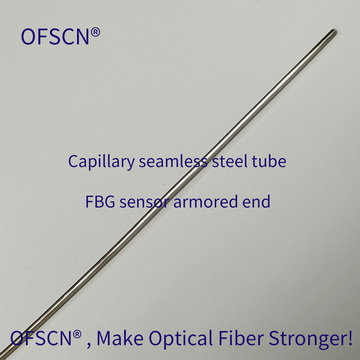This article analyzes the advantages and benefits brought by good pressure resistance in FBG sensors, including the expansion of application environments and the convenience in engineering construction. It also introduces the "OFSCN® Capillary Seamless Steel Tube Series Fiber Bragg Grating Sensor" produced by DCYS (These series of products are all high-pressure-resistant fiber optic gratingFBG sensors used for temperature, strain, or stress measurements). It shows part of the physical illustrations and parameters.
1. Structure and Advantages of High-Pressure-Resistant Fiber Bragg Grating Sensors (FBG Sensors) ( FBG Thermometer, FBG Temperature Probe )
The ability to resist pressure (external, internal, and lateral) directly determines the environments in which FBG sensors can be used and also affects the engineering construction of FBG sensors (FBG probes). Let's briefly explain the advantages brought by good pressure resistance for FBG sensors (FBG probes) from the perspective of pressure resistance.
 |
| Figure 1 |
The "OFSCN® Capillary Seamless Steel Tube FBG Sensor" produced by DCYS is made of stainless steel seamless tubes. Benefiting from the characteristics of stainless steel material and seamless tube structure, this series of FBG sensors ( FBG probes) has high pressure resistance. The high pressure resistance mentioned here includes the ability to withstand external pressure, internal pressure, and lateral pressure.
 |
 |
|
Figure 2 |
Figure 3 |
2. Pressure Resistance of OFSCN® Capillary® Seamless Steel Tube Fiber Bragg Grating Sensors (FBG sensors, FBG probes)
The main body of the OFSCN® Capillary Seamless Steel Tube FBG sensor ( FBG probe) is made of stainless steel seamless tubes. The standard outer diameter of the OFSCN® Capillary Seamless Steel Tube FBG sensor ( FBG probe) is 0.9 mm, with a wall thickness of 0.18 mm (see Figures 1 and 2). Based on our calculations, the pressure resistance of the main body of the sensor is greater than 180 MPa (external pressure).。
 |
|
Figure 4 |
The number 180 MPa may not be intuitively understandable to many people. In daily life, atmospheric pressure is approximately 0.1 MPa, which is roughly equivalent to the pressure of water at a depth of 10 meters underwater. 1 MPa is approximately the pressure of water at a depth of 100 meters underwater, and 180 MPa is roughly the pressure of water at a depth of 18,000 meters underwater.
The deepest known point on Earth is the Mariana Trench, with a depth of 11,034 meters (approximately 110 MPa of pressure). If someone commissioned us to produce an OFSCN® Capillary Seamless Steel Tube FBG Sensor of such length and threw it into the deepest part of the Earth for fiber sensing, there would be no problem. Our sensor would not be damaged by the water pressure at that depth. Because our philosophy is: "OFSCN®, make optical fiber stronger!"
 |
|
Figure 5 |
In terms of pressure resistance, there is no comparison between OFSCN® Capillary Seamless Steel Tube FBG Sensors and traditional FBG sensors. They are not product in the same level, so there is no need to elaborate further.
3. Application and Construction Advantages of OFSCN® Capillary Seamless Steel Tube Fiber Bragg Grating Sensors (FBG sensors , FBG probes) with High Pressure Resistance
The high pressure resistance of OFSCN® Capillary Seamless Steel Tube FBG Sensors greatly expands their range of applications. In the past, it was challenging to measure high-pressure locations deep within the Earth, but with the availability of OFSCN® seamless steel tube products (including FBG sensors, distributed fiber optic sensors, special fiber optic jumpers, and seamless steel tube sensing cables), communication and measurement in these high-pressure locations have become less difficult.
In terms of engineering construction, similar to the advantages of high tensile strength, the high pressure resistance of OFSCN® Capillary Seamless Steel Tube FBG Sensors directly reduces the difficulty and losses in construction, thus lowering the installation cost of the grating sensors.
Furthermore, it is inevitable that collisions occur during engineering construction, and the grating sensors may be directly covered or squeezed by other materials or objects under test. In such situations, the sensors' ability to withstand lateral pressure becomes crucial.
Based on our calculations, the standard OFSCN® Capillary Seamless Steel Tube FBG Sensor can withstand lateral pressure of more than 9000 N. In practical applications, our FBG sensors can be placed on the road surface and withstand repeated pressure from small cars. Apart from surface wear, there will be no actual damage to the sensors.
